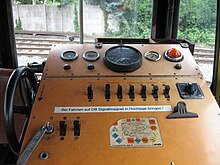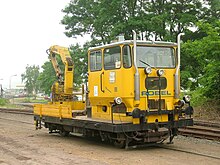DB class Klv 53
| Klv 53 | |
|---|---|
|
Klv 53-0632 in Hagen / Westphalia
|
|
| Numbering: | Klv 53-0001 – Klv 53-0138 a Klv 53-0139 – Klv 53-0684 b Klv 53-0685 – Klv 53-0824 c |
| Number: | 824 |
| Manufacturer: | various (see text) |
| Year of construction (s): |
a 1963–1969 b 1970–1977 c 1978–1981 |
| Axis formula : | B. |
| Gauge : | 1435 mm ( standard gauge ) |
| Length over coupling: | 6,370 mm |
| Height: | 3,030 mm (without exhaust pipe) |
| Width: | a 2,400 mm or b, c 2,600 mm |
| Total wheelbase: | 3,750 mm |
| Payload: | 8.0 t |
| Service mass: | 8.0 t |
| Top speed: | 70 km / h |
| Traction power: |
a 57 kW (77 PS) b 85 kW (116 PS) c 110 kW (150 PS) |
| Driving wheel diameter: | 700 mm |
| Motor type: |
a KHD A4L 514 b KHD F6L 413 V c KHD F6L 413 F |
| Motor type: | air-cooled a 4-cylinder in-line or b, c 6-cylinder V-diesel engine |
| Power transmission: | mechanical a 4 or b, c 5-speed gearbox |
| Tank capacity: | 100 liters |
| Brake: | a, b direct and c indirect pneumatic disc brake |
| Coupling type: | Truck coupling |
The Klv 53 heavy-duty car is an auxiliary vehicle for track construction and maintenance work. From 1963 the German Federal Railroad procured a total of 824 cars of this type, which makes it the most frequently built company vehicle on a German state railroad .
Development and construction

In the early 1960s, DB began in cooperation with the firm Schöma with the advancement of since 1955 procured rotting cars of the DB class Klv 50 / Klv 51. A serious disadvantage of very successful design is the lack of opportunity, the rotting workers a weatherproof and heated transportation option to be able to offer. Furthermore, the low top speed of only 50 km / h hampered rail operations.
For this reason, Schöma developed a larger driver's cab for the Klv 50 / Klv 51 in cooperation with the Bundesbahnzentralamt (BZA) in Munich, which can accommodate six other people in addition to the driver. In the prototypes, it was heated by means of waste heat from the engine compartment. While this type of heating was still sufficient for the small cabs of the Klv 50 / Klv 51, it reached its limits in the large-volume Klv 53 cabs. The insufficient output of this type of heating was compensated for in the series delivery by installing a Webasto warm air heater. By increasing the impeller diameter (from 600 mm to 700 mm) and increasing the engine speed (from 2000 rpm to 2300 rpm), it was also possible to increase the maximum permissible speed from 50 km / h to 70 km / h. Maintaining the narrow loading areas on both sides of the engine compartment enabled the transport of long material, such as rails .
With these changes, Schöma delivered three “Klv 51s in special design” in 1963 and 1964, which initially received their company numbers Klv 51-9162, Klv 51-9163 and Klv 51-9164 from the Klv 51 series delivery. Due to the significant structural deviations from the series Klv 51, the new series Klv 53 was created for these three vehicles shortly after they were put into operation. In the second half of 1964 they were renamed Klv 53-0001 to Klv 53-0003.
First of all, the delivery of the series of the Klv 51 series that was still under construction was completed by early 1965. The series deliveries of the new Klv 53 series that followed this series received almost all changes to the 3 prototypes. Only the loading door on the left side of the driver's cab (behind the driver's seat) did not go into series production.
The first 39 vehicles were built by Schöma until 1966, the following vehicles were manufactured by Industriewerken Karlsruhe (IWK) , Robel , Sollinger Hütte (SH), Deutsche Waggon- und Maschinenfabrik, from 1971 Waggon Union (DWM / WU) and Windhoff . From 1963 to 1981, 824 vehicles in 13 series were procured by the DB. By using more powerful KHD engines during the delivery period, the output was increased from 77 hp (F4L 514) and 116 hp (F6L 413 V) to 150 hp (F6L 413 F).
Instead of the hydraulic still on the first 16 vehicles as recently established in Klv 51 Atlas - loading crane AK 1400 DB 3001 DB has already been used in the second production run of stronger Atlas AK. The further developed Atlas AK 3006 DB was later used. At the same time, the equally powerful Meiller MK 80 R DB loading crane was erected at times . The last series received the Atlas loading crane AK 3006 A DB with an additional extension arm and height limitation that can be switched off.
Even after the end of series production of the Klv 53 for the German Federal Railroad, Schöma continued to deliver other vehicles to other railway companies in Germany and abroad until 1994, some of which were slightly modified.
designation
The designation Klv 53 corresponds to the Bundesbahn designation scheme for small cars. The abbreviation Klv stands for Kl einwagen with V erbrennungsmotor, the number 53 refers to the development of severe rotting cars of the unit type (according to the DB-series Klv 50, 51 and Klv Klv 52). The design differences with regard to the loading crane and braking system are identified by a three-digit designation between 530 and 538.
commitment
According to the design, the Klv 53 was mainly used in track construction and in the maintenance of railway systems. The large cab and the larger payload made it easier to transport workers and material than older designs, the stronger loading crane made it easier to reload material, and the hydraulic system also allowed the use of various attachments on the crane arm. Additional attachments for the vehicle could also be used for special tasks, for example for applying weed control agents.
Some vehicles have been given special equipment for other tasks:
- In particular, in the Alpine foothills, some Klv were 53 with a built onto the back snowblower from Beilhack used type HS 270 K. The Klv 53-0164 was used as the first Klv 53. Under him, a lifting and rotating device was installed by the Beilhack company in Rosenheim in 1970, immediately after its delivery to the DB. After the Klv 53-0164 was taken out of service on December 31, 1989, the milling machine was moved to other vehicles.
- For maintenance of the signal systems in the S-Bahn and airport tunnels in Munich, Hamburg and Frankfurt (M.), some of which are still under construction, 6 Klv 53 of the type 533 (Klv 53-0533 - 0538) were built in 1973 of the loading crane were delivered with an Atlas AK 1400 H lifting basket . On several of these Klv 53s, the lifting cage was later removed and an Atlas AK 3001 DB loading crane installed.
- Before welding a rail joint , the rails must be heated in order to avoid undesirable stresses after the weld has cooled. For this purpose, some Klv 53s were equipped with a rail heater with propane firing, which is installed in front of the cabin. In the transport position it is set up vertically, it can be lowered onto the rails to warm up, the fuel is carried on the trailer.
- To maintain the very low working speed when heating the rails with the rail heating device, 19 Klv 53 units with an additional hydraulic drive were procured. To distinguish them, these vehicles were given a vehicle code number increased by 4000 (Klv 53-4730 - 4743 and Klv 53-4775 - 4779).
- At least 2 vehicles were delivered as type 532 without a loading crane (Klv 53-0165, -0166) or it was subsequently dismantled.
- Klv 53-0317 with its trailer Kla 03-0345 was a unique piece. This combination was used by the Osnabrück catenary maintenance company for electrification work. For this purpose, the Klv had a workshop and equipment room built onto the loading area, while the trailer had another work area and an aerial work platform.
Due to their large number of units, the yellow painted Klv 53 were present at almost every West German train station, which meant that they could be counted among the most typical vehicles of the Federal Railroad, but were also hardly noticed by railway photographers.
From around the 1990s onwards, the Deutsche Bundesbahn and its successor Deutsche Bahn tried to make the maintenance of the rail network, which had previously been very labor-intensive, more economical through numerous decentralized railway maintenance companies. For this purpose, many railway maintenance depots were closed or merged into larger central locations, which accordingly required fewer vehicles. In addition, the first deliveries of the type GAF100 , which can be regarded as the successor series of the Klv 53 and other Rotten vehicles, took place from 1994 onwards . Most of the Klv 53 were subsequently taken out of service, and in 2013 some vehicles were still in service with the DB subsidiary Deutsche Bahn Gleisbau .
Numerous Klv 53s, however, ended up in private companies after being retired by the DB. In addition to many railway companies that use the vehicles to maintain their own routes, some track construction companies also acquired Klv 53, which often also use them for construction work on DB routes. Furthermore, copies were also sold through dealers abroad and to special vehicle rental companies. Numerous museum railways also use Klv 53 to maintain their routes. Some of the vehicles were modernized or otherwise modified after the sale.
Individual evidence
- ↑ a b c d e f Description of the Rottenkraftwagen Klv 53. DV 931/300; Valid from January 1, 1972 to Deutsche Bundesbahn, 1972
- ↑ a b Andreas Christopher, Ulrich Völz: 75 years of Schöma. Christoph Schöttler Maschinenfabrik GmbH 1930–2005 . Die Feldbahn, Volume 7. Verlag Ingrid Zeunert, Gifhorn 2005, p. 49, ISBN 3-924335-42-7
- ↑ Description of the Klv 53 with snow blower on eisenbahndienstfahrzeuge.de
- ↑ Overview of small cars with internal combustion engine Klv 53 on eisenbahndienstfahrzeuge.de
Web links
- Small car Klv 53 (Rottenkraftwagen). In: bahndienstwagen-online.de. Retrieved on November 26, 2019 (extensive image material on Klv 53).
- The small cars of the DB between 1950 and 1990. In: Nebenfahrzeuge.de. Retrieved on November 26, 2019 (website about auxiliary vehicles with extensive descriptions and the résumés of all Klv 53s).
- Klv 53. In: privat-bahn.de. Retrieved on November 26, 2019 (description of the Klv 53).
- Railway service vehicles. In: eisenbahndienstfahrzeuge.de. Retrieved on November 26, 2019 (website about railway service vehicles with a comprehensive description of the Klv 53).






